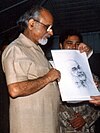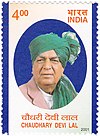Type a search term to find related articles by LIMS subject matter experts gathered from the most trusted and dynamic collaboration tools in the laboratory informatics industry.
Janata Dal | |
|---|---|
 | |
| Abbreviation | JD |
| Founder | V. P. Singh |
| Founded | 11 October 1988 |
| Dissolved | 2003 |
| Merger of | |
| Succeeded by | |
| Political position | Centre[2] |
| National affiliation |
|
| Colours | Green |
Janata Dal ("People’s Party") was an Indian political party which was formed through the merger of Janata Party factions, the Lok Dal, Indian National Congress (Jagjivan), and the Jan Morcha united on 11 October 1988 on the birth anniversary of Jayaprakash Narayan under the leadership of V. P. Singh.[3][4]
V. P. Singh united the entire disparate spectrum of parties ranging from regional parties such as the Telugu Desam Party, the Dravida Munnetra Kazhagam, and the Asom Gana Parishad, together and formed the National Front with N. T. Rama Rao as President and V. P. Singh as convenor. The front also included outside support from the right-wing Bharatiya Janata Party and the left-wing Left Front, led by the Communist Party of India and Communist Party of India (Marxist). They defeated Rajiv Gandhi's Congress (I) in the 1989 parliamentary elections.[5][6] His government fell after Lalu Prasad Yadav got Advani arrested in Samastipur and stopped his Ram Rath Yatra, which was going to Ayodhya on the site of the Babri Masjid on 23 October 1990, and the Bharatiya Janata Party withdrew support. V. P. Singh lost a parliamentary vote of confidence on 7 November 1990.[7] In the 1991 Indian general election the Janata Dal lost power but emerged as the third largest party in Lok Sabha.[8] The Janata Dal-led United Front formed the government after the 1996 Indian general election with the outside support of the Indian National Congress. However, after this the Janata Dal gradually disintegrated into various smaller factions, which largely became regional parties such as Biju Janata Dal, Rashtriya Janata Dal, Janata Dal (Secular) and Janata Dal (United).[9]

It first came to power in 1989, after cases of corruption, known as the Bofors scandal, caused Rajiv Gandhi's Congress (I) to lose the elections. The National Front coalition that was formed consisted of the Janata Dal and a few smaller parties in the government, and had outside support from the Left Front and the Bharatiya Janata Party. V. P. Singh was the prime minister. In November 1990, this coalition collapsed, and a new government headed by Chandra Shekhar under Samajwadi Janata Party (Rashtriya) which had the support of the congress came to power for a short while. Two days before the vote, Chandra Shekhar, an ambitious Janata Dal rival who had been kept out of the National Front government, joined with Devi Lal, a former deputy prime minister under V. P. Singh, to form the Samajwadi Janata Party, with a total of just sixty Lok Sabha members. The day after the collapse of the National Front government, Chandra Shekhar informed the president that by gaining the backing of the Congress (I) and its electoral allies he enjoyed the support of 280 members of the Lok Sabha, and he demanded the right to constitute a new government. Even though his rump party accounted for only one-ninth of the members of the Lok Sabha, Chandra Shekhar succeeded in forming a new minority Government and becoming Prime Minister (with Devi Lal as deputy prime minister). However, Chandra Shekhar's government fell less than four months later, after the Congress (I) withdrew its support.[10]

Its second spell of power began in 1996, when the Janata Dal-led United Front coalition came to power, with outside support from the congress under Sitaram Kesri, choosing H. D. Deve Gowda as their prime minister. The Congress withdrew their support in less than a year, after the H. D. Deve Gowda Government restarted probing the corruption cases against a lot of Congress leaders, hoping to gain power with the support of various United Front constituent groups, and I. K. Gujral became the next prime minister. His government too fell in a few months, and in February 1998, the Janata Dal-led coalition lost power to the Bharatiya Janata Party in General Elections.[citation needed]
| No. | Image | Prime ministers | Year | Duration | Constituency |
|---|---|---|---|---|---|
| 1 |  |
Vishwanath Pratap Singh | 1989 – 1990 | 343 days | Fatehpur |
| 2 |  |
H. D. Deve Gowda | 1996 – 1997 | 324 days | — (Rajya Sabha MP) from Karnataka |
| 3 |  |
Inder Kumar Gujral | 1997 – 1998 | 332 days | — (Rajya Sabha MP) from Bihar |
| No. | Portrait | Chief Ministers | State | Year | Duration |
|---|---|---|---|---|---|
| 1 |  |
Mulayam Singh Yadav | Uttar Pradesh | ||
| 2 | Chimanbhai Patel | Gujarat | |||
 |
Lalu Prasad Yadav | Bihar | |||
 |
Biju Patnaik | Odisha | |||
 |
H. D. Deve Gowda | Karnataka | |||
| J. H. Patel | Karnataka | ||||
 |
Devi Lal | Haryana | |||
 |
Om Prakash Chautala | Haryana | |||
 |
Banarsi Das Gupta | Haryana | |||
| Hukum Singh | Haryana |
| Year | Seats won | Votes | ||
|---|---|---|---|---|
| 1989 Indian general election | 143 | 53,518,521 | ||
| 1991 Indian general election | 59 | 32,628,400 | ||
| 1996 Indian general election | 46 | 27,070,340 | ||
| 1998 Indian general election | 6 | 11,930,209 | ||
| Party Disintegrated | ||||
| No. | Portrait | Vice President | Year | Duration |
|---|---|---|---|---|
| 1 | 
|
Krishan Kant | 21 August 1997 – 27 July 2002 | 4 years, 340 days |
| No. | Portrait | Deputy Prime Minister | Year | Duration |
|---|---|---|---|---|
| 1 | 
|
Devi Lal | 10 November 1990 – 21 June 1991 | 242 Days |
| No. | Portrait | Presidents | Year | Duration |
|---|---|---|---|---|
| 1 |  |
Vishwanath Pratap Singh | 1989-1997 | days |
| 2 |  |
Sharad Yadav | 1997-1999 | days |
| No. | Portrait | Deputy Chief Minister | State | Year | Duration |
|---|---|---|---|---|---|
| 1 | Banarsi Das Gupta | Haryana | |||
| 2 | Hukam Singh | Haryana | |||
| J. H. Patel | Karnataka | ||||
| K. Siddaramaiah | Karnataka |

Thakur Ji Pathak (1989 – 1994)- National General Secretary [11]
Anantram Jaiswal (1983)
B. Rachaiah (1989)[12]
Siddaramaiah (Feb 1999)[13]
C. Byre Gowda (July 1999)[14]
Jeevaraj Alva (1989-1990)[15][12]
C. Narayanaswamy (1999)[14]
Sivaji Ganesan (1989-1993)
In this vacuum, the BJP's path to power followed that of three other centrist parties, similar to Congress, which led coalitions on three separate occasions.
{{cite web}}: CS1 maint: numeric names: authors list (link)